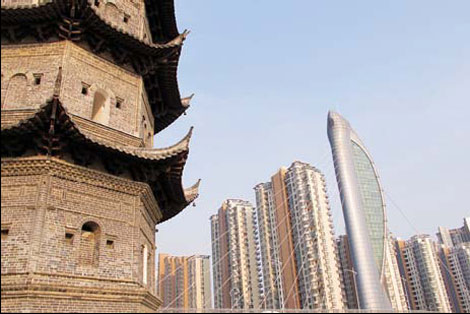Wuhu's faded glories shine with a contemporary charm
Updated: 2012-02-16 11:03
By Wang Kaihao (China Daily)
|
||||||||
 |
|
Ancient towers and skyscrapers stand side-by-side in Wuhu, Anhui province. [Wang Kaihao / China Daily] |
My hometown | Wang Kaihao
Many people from Wuhu, Anhui province, choose to return to their hometown to spend their twilight days - even though they have lived in other big cities for years.
"The city is smaller, but we have everything here," the elderly always say to me.
Every time I return to Wuhu, the first thing I do is take a walk along the bank of the Yangtze River, which is just 300 meters from my home.
Watching the waves splashing against rocks, enjoying the beautiful sunset and hearing the roaring engines of fishing boats, I feel at ease - and this is one of the best things about Wuhu.
The urban area spreads along the riverbank like a ribbon. I used to walk from the westernmost part to the east within an hour. Now the walk takes longer as the city is getting "fatter", with more residential areas.
The 309-km-long Qingyi River flows into the Yangtze in downtown Wuhu. The alluvia in the estuary offers a lot of fun. Many ships sank there in the ancient times, so you may find treasures or antiques if you are lucky.
I went there a couple of times, but only found some fragments of bowls and vases from the Ming Dynasty (1368-1644).
The merchants from southern Anhui province were a strong power in the country's economy from the 14th century to the late 19th century. They transported tea, paper, rice and salt on the Qingyi River to Wuhu and then transferred it via the Yangtze to other parts of the country.
During its prime in the Qing Dynasty (1644-1911), the port city was a commercial hub boasting one of the biggest rice markets along the Yangtze.
During the 19th century, as a result of concessions granted in the aftermath of the Opium Wars, Wuhu's riverfront was carved up into foreign mercantile divisions, with port facilities.
As Western merchants and missionaries swarmed in, the local merchants' business began to fade.
Along the city's riverfront, there remain some grand buildings designed in European style.
St. Joseph Catholic Church, one of the largest cathedrals in eastern China, stands on the riverbank, accompanied by a Western-style former customs building.
Foreign missionaries also established the city's first modern school and hospital, which are both in working order today.
The scene may remind you of the Bund in Shanghai. Indeed, Wuhu was called "Little Shanghai" in the early 1900s for its multicultural atmosphere and booming manufacturing industry.
Wuhu, which means "a lake filled with wild weeds", got its name in the Western Han Dynasty (206 BC-AD 24).
Mirror Lake, one of the city's must-see sites, is adjacent to Zhongshan Pedestrian Street, the city's busiest commercial district, which is named after Dr Sun Yat-sen because of his visit in 1912. Put Beijing's Wufujing Street beside Hangzhou's picturesque West Lake - that's how it feels.
This artificial lake was dug in the Southern Song Dynasty (1127-1279) and was named Tao Pond in honor of the famous poet in the 4th century, Tao Yuanming.
Despite its closeness to the shopping center, you can still easily escape from the hustle and bustle and enjoy a peaceful moment in the park along the lakeshore.
You can take a picture on a zigzagging bridge against the backdrop of a mirror-like lake and the virid Mount Zheshan in the distance. The 84-meter-high hill is an extinct volcano and one of the highest points in the urban area.
It's easy to spend hours by the lake - sitting on a park bench shaded by willows, having a cup of tea and chatting with old friends.

 'Taken 2' grabs movie box office crown
'Taken 2' grabs movie box office crown
 Rihanna's 'Diamonds' tops UK pop chart
Rihanna's 'Diamonds' tops UK pop chart
 Fans get look at vintage Rolling Stones
Fans get look at vintage Rolling Stones
 Celebrities attend Power of Women event
Celebrities attend Power of Women event
 Ang Lee breaks 'every rule' to make unlikely new Life of Pi film
Ang Lee breaks 'every rule' to make unlikely new Life of Pi film
 Rihanna almost thrown out of nightclub
Rihanna almost thrown out of nightclub
 'Dark Knight' wins weekend box office
'Dark Knight' wins weekend box office
 'Total Recall' stars gather in Beverly Hills
'Total Recall' stars gather in Beverly Hills
Most Viewed
Editor's Picks

|

|

|

|

|

|
Today's Top News
Health new priority for quake zone
Xi meets US top military officer
Japan's boats driven out of Diaoyu
China mulls online shopping legislation
Bird flu death toll rises to 22
Putin appoints new ambassador to China
Japanese ships blocked from Diaoyu Islands
Inspired by Guan, more Chinese pick up golf
US Weekly

|

|






